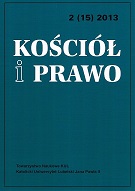Symbol krzyża w sferze publicznej w kontekście wybranych orzeczeń
The symbol of the cross in the public sphere in the context of the selected judgments
Author(s): Agnieszka RomankoSubject(s): Law, Constitution, Jurisprudence
Published by: Towarzystwo Naukowe KUL & Katolicki Uniwersytet Lubelski Jana Pawła II
Keywords: cross; religious symbol; Lautsi versus Italy; religious freedom; krzyż; symbol religijny; Lautsi przeciwko Włochom; wolność religijna
Summary/Abstract: There are lively debates – both in Poland and in Europe – concerning the symbol of the cross in the public sphere. Opponents of the exposition of the cross in public places in secular state claim that such situations may suggest identification with specific religion. They maintain that the cross is just a religious symbol without any further meaning. The main purpose of this article is to show the historical and cultural meaning of the cross in the context of the selected judgments. The Author makes an attempt to answer the question: Why do people think that cross does not have any further meaning apart from religious values? There is analyses of selected judgments of Polish courts and the judgement of European Court of Human Rights in the case of Lautsi v. Italy. At the beginning there is presentation of the sign of the cross in Polish culture and history. In judicial decisions it was emphasised that this sign symbolizes the universal values derived from Christian tradition, which is part of Polish material and spiritual culture. Such an invincible belief is embedded in the minds of Poles since the beginning and no one is competent to deprive of this conviction. In Italian history the cross also has significant meaning. It reminds of the principles which can be respected by all people regardless of their faith. The showing of democracy is included without the values symbolised by the cross. It is necessary to conduct a dialogue with respect for religious freedom and other people.
Journal: Kościół i Prawo
- Issue Year: 2/2013
- Issue No: 2 (15)
- Page Range: 207-226
- Page Count: 20
- Language: Polish

